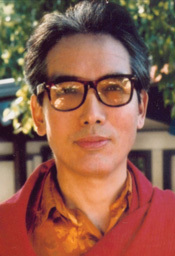Traleg Kyabgon
Born
Kham (Eastern Tibet)
Died
July 24, 2012
Website
Genre
Influences
16th Gyalwa Karmapa, Milarepa, Nagarjuna, Asanga, Ken Wilber
...more
More books by Traleg Kyabgon…
“He believed fully that whatever suffering we experience is due to our own doing, and not due to a divine hand. Therefore, the pacification of suffering is also in our own hands. This was his idea of karma.”
― Karma: What It Is, What It Isn't, Why It Matters
― Karma: What It Is, What It Isn't, Why It Matters
“Karmic Cause and Effect It is very important to contemplate the connection between our mental states and our actions. Our karmic patterns are formed and sustained by the intentional actions of the “three gates” of body, speech, and mind—everything we do, say, or think with volitional intention. Our actions and reactions form the cause and effect of action (Skt. karma; Tib. las) that in turn determines the kinds of experiences we have. As such, our mind has the potential to transport us to elevated states of existence or to plunge us into demeaning states of confusion and anguish. Our actions are not like footprints left on water; they leave imprints in our minds, the consequences of which will invariably manifest unless we can somehow nullify them. As the thirteenth Karmapa, Dudul Dorje (1733–97) states: In the empty dwelling place of confusion, Desire is unchanging, marked on the mind Like an etching on rock.13 The thoughts and emotions we experience and the attitudes and beliefs we hold all help to mold our character and dispositions and the kind of people we become. Conditioned existence is characterized by delusions, defilements, confusions, and disturbances of all kinds. We have to ask ourselves why we experience so much pain, while our pleasures are so ephemeral and transient. The answer is that these are the karmic fruits of our negative actions (Skt. papa-karma; Tib. sdig pa’i las). Jamgön Kongtrül says: The result of wholesome action is happiness; the result of unwholesome action is suffering, and nothing else. These results are not interchangeable: when you plant buckwheat, you get buckwheat; when you plant barley, you get barley.14 This cycle of cause and effect continues relentlessly, unless we embark on a virtuous spiritual path and learn to reverse this process by performing wholesome actions (Skt. kusala-karma; Tib. dge ba’i las). It is our intentions that determine whether an action is wholesome or unwholesome, and therefore it is our intentions that will dictate the quality of our future experiences. We have to think of karmic cause and effect in the following terms: “My current suffering is due to the negative actions, attitudes, thoughts, and emotions I performed in the past, and whatever I think, say, and do now will determine what I experience and become in the future. So from now on, I will contemplate the truth of karma, and pursue my spiritual practices with enthusiasm and positive intentions.”
― The Practice of Lojong: Cultivating Compassion through Training the Mind
― The Practice of Lojong: Cultivating Compassion through Training the Mind
“When we begin to practice tranquillity meditation, it may be difficult to maintain this awareness. That’s why we focus on the exhalation and inhalation of the breath rather than on what is going on in the mind, because focusing on our thoughts and emotions is much more difficult. We can formalize this technique by counting the incoming and outgoing breaths, in whatever rhythm is natural for us. In the beginning, you count an exhalation and inhalation as one breath and continue counting until you reach seven breaths, before returning to the count of one again. When we breathe out, we should know that we are breathing out, and when we breathe in, we should know that we are breathing in. When you’re comfortable counting seven breaths, you increase the number to fifteen and then to twenty-one. When you can hold your attention on the breath for twenty-one cycles, you will have developed some proficiency in mindfulness.”
― The Practice of Lojong: Cultivating Compassion through Training the Mind
― The Practice of Lojong: Cultivating Compassion through Training the Mind
Topics Mentioning This Author
| topics | posts | views | last activity | |
|---|---|---|---|---|
| Stress Free Readi...: Candy Craze Challenge | 148 | 390 | Apr 20, 2019 08:42AM |







































